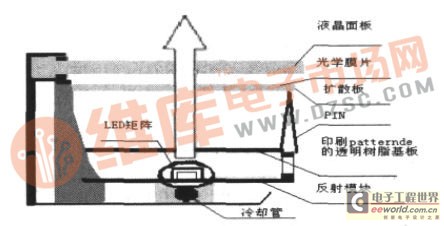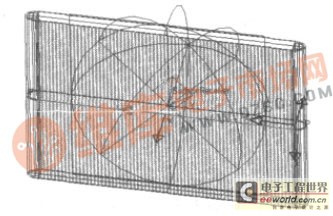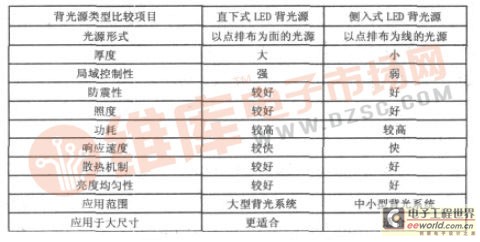introduction
The direct-lit LED backlight has higher color reproduction, power saving, long life and vibration resistance, and is not affected in low temperature environment. As LEDs have these advantages, more and more manufacturers have begun to develop large-size direct-lit LED backlights. However, since the thickness of the direct type is relatively thick compared to the side entry type, the side-entry type in the small and medium-sized LCD liquid crystal display system accounts for a larger proportion than the direct type structure.
In recent years, Samsung has launched a 52-inch full HD LED LCD TV "PAVV-LED52" in South Korea. The 52-inch full-HD LED-backlit LCD TV released this time uses a "Chameleon LED Backlight" technology developed by Samsung to reduce the backlight brightness of the dark image portion. Dynamic contrast ratio of 500,000:1, power consumption can be reduced by up to 50%. Moreover, with the high-speed image mode, it is possible to achieve image blurring with less image blur and residual images. From this point of view, LED backlight performance has completely surpassed CCFL backlights has become possible.
1 LED backlight design method
1.1 System Overview
Taking a backlight module with a diagonal length of 15 inches, that is, a length, a width, and a height of 89.44 mm, 67.08 mm, and 5 mm, respectively, the brightness required for the design is 1,200 cd/m 2 after passing through the liquid crystal display, and brightness uniformity is achieved. It can reach more than 85%, the power is less than 50W; the working temperature is -40°C~60°C, the brightness is adjustable, and the adjustment range is wide and the adjustment precision is high.
In order to meet the above requirements, in order to make the backlight module work better, the system design should include functional modules such as overvoltage protection and high temperature protection. The following requirements are given as the above requirements, and our LED backlight design scheme and the problems that will be encountered in the realization of high-brightness backlight design with high-power white LEDs are presented based on the final performance test results, and solutions are proposed.
1.2 Direct-type LED backlight structure
The LED backlight process is to convert the LED point source into a uniform surface source. According to the position of the light source, it is divided into two types: side light type and direct type. In order to realize the design of the backlight module with high brightness uniformity, it is first necessary to select the system structure form constituting the backlight module. This article uses a direct structure.
When the edge-lit LED backlight is applied to a large and medium-sized LCD, the weight and cost of the light guide plate will increase with the increase of the size, and the uniformity of illumination and the brightness of the light are not ideal, while the performance of the direct-lit LED backlight is better. The direct-type backlight process is relatively simple, and does not require a light guide plate. The light source (LED chip array) and the PCB are placed at the bottom of the backlight. After the light is emitted from the LED, it is scattered by the scattering film to obtain a uniform uniform scattered light. The scattered light is concentrated at a certain emission angle by a direction perpendicular to the film by two prism films (horizontal and vertical directions BEF1 and BEF2, respectively). In order to make better use of light energy and improve overall efficiency, we have added a reflective film on the surface of the bottom plate LED lamp. Experiments have shown that the presence of the reflective film increases brightness and efficiency by nearly 20%. At the same time, a layer of light-guiding glue containing a scattering agent is coated on the bottom light source. The thickness of the light-guiding glue depends on the height of the cavity and the characteristics of the light-guiding glue, and mainly serves two functions: 1 improving brightness uniformity; 2 protecting the LED chip, Improve reliability.
The thickness of the backlight is determined by the height of the cavity between the reflective film and the diffuser plate. Theoretically, under the premise of meeting the installation requirements and the brightness of the light, the greater the height of the cavity, the better the uniformity of light emitted from the diffusing plate. The structure of the direct-lit LED backlight is shown in Figure 1. The key to direct-lit backlight technology is to control brightness uniformity and improve luminous efficiency. A certain space must be reserved between the scattering film and the LED light source to improve the brightness uniformity, so the thickness of the direct type backlight is relatively thick. Due to the large number of light sources, the brightness and power consumption of the light are greater than that of the edge-lit backlight. The heat energy released by the LED die is concentrated in the cavity. In the design of large-area, high-brightness LED backlight products, the module heat sink should be considered.

Figure 1 Schematic diagram of optical system structure control
We use white LEDs produced by Lumileds, the typical current is 700mA, the rated power is 3W, the luminous intensity is 80lm, the divergence angle is 120°, and the photoelectric characteristics are screened for uniformity. The LED with better matching is selected as the system light source. .
High-power LEDs emit a lot of heat when they are working at a typical current, which is prone to high temperatures and affects the liquid crystal display. For this reason, we derate it, increase the number of lamps, and reduce the operating current, thus alleviating High temperature problems, and most lamps can achieve better results in uniformity.
Based on the above factors, we arranged 64 lamps in the effective area of ​​the backlight panel. Each of the 8 lamps was connected in series as a group. The 64 lamps were divided into 8 groups and then connected in parallel. Tracking about 1000,000 rays, the analysis results show that the total luminous flux of 52 lumens is emitted from the surface of the light guide plate, and the uniformity of illumination distribution is more than 80%, which basically meets the requirements of the backlight system. As shown below: The following is a backlight simulation using LightTools optical simulation software (Figure 2) and backlight brightness distribution (Figure 3):

Figure 2 backlight simulation

Figure 3 backlight brightness distribution map
For the distance from the optical film to the backlight (ie the height of the backlight cavity), we did some experiments. The results show that when the LED lamp arrangement is 15mm, the "LSD scattering film + BEF vertical + BEF parallel" is used. When the optical film is combined, the backlight cavity height is 18 mm, the lamp shadow of the LED lamp is not seen, and the brightness uniformity is good. Through the simulation calculation, the uniformity is 87%, which can be seen from the diagram and meets the design requirements.
Comparison of light source characteristics:
At present, the direct type occupies the high end of the LED, while the side-in type occupies the low end of the LED; the direct type gradually replaces the side-in type, and the small and medium-sized color LCD (such as mobile phone, MP3, PSP, etc.) generally uses a side-in LED backlight. Because the cost of an LED is similar to that of a CCFL cold cathode, but because of the small size of the LED, in the backlight system, it is necessary to distribute a plurality of LEDs according to the screen size and the like, and the cost is relatively considerable, so the side-entry LED is relatively large. The backlight can use less LED chips to save cost. The second is to create a slim and light body. The LED TV LCD panel does not need to be equipped with LED modules at the rear, but is placed on the side to reduce the overall screen. Thickness, to create a thinner model than the direct-lit LED-backlit LCD TV, but due to the structural defects of the LED side-in arrangement, the backlight is affected in terms of brightness uniformity and illumination, especially for military and aviation projects. When it comes to precision instruments, it requires a backlight with high brightness, uniformity and relative reliability. The advantage of using the direct type is that the LED backlight liquid crystal display adopts a matrix arrangement manner, and combines the light emission in a series-parallel manner, and can respectively set different backlight module rights and responsibilities regions, and theoretically, each LED can independently control the brightness. However, the line and design cost are not easy. In fact, multiple areas are set in the backlight of the screen, so that these areas can independently adjust the brightness. Not only the efficiency of the light extraction rate is gradually increased, but also under vibration. Under the impact, there is a good guarantee structure setting, which will not affect the use. The comparison of various technical indicators of direct-lit LED and side-in LED backlight is shown in Table 1.
Table 1 Comparison of direct-lit LED backlights and side-in LED backlights

3 LED direct-lit structure backlight module application prospects
At present, from the luminous efficiency and cost issues, the backlight system with a cold cathode tube (CCFL) as the backlight is significantly better than the backlight system with LED as the backlight. The price of an LED itself is not higher than that of a CCFL cold cathode tube. However, due to its small size and low luminous power limitation, in a backlight module, multiple LED strings are required to be connected in parallel to form an equally spaced structure for illumination. The cost is considerable, which is a key factor that has prevented the structure from becoming a backlight for large displays. However, with the rapid development of high technology, the development of the LED industry is extremely rapid, and the luminous efficiency is also increasing quite fast. At present, the LED backlight has a dominant price for small and medium-sized display panels with a diagonal of 18 cm or less, and the price in the large-size range is 4 to 5 times that of CCFL backlights. It is expected that with the expansion of industrial scale and technical processes. Gradually mature, the cost of LED cost will be solved accordingly.
The ultra-thin backlight product with an equally spaced LED direct-down structure is a new type of projection display technology, which has lighter weight, thinner thickness, lower power consumption, better brightness uniformity and shape than the conventional projection backlight system. Beautiful and other advantages. At the same time, it can be widely used in large and medium size LCD panel market and small size mobile phone screen panels and modern public advertising media light boxes. It is a product of high technology that is formed by multidisciplinary integrated technology. At present, this research work is at the leading level in China, with broad application prospects and good economic benefits.
4 Conclusion
As a new type of backlight, the direct-lit LED backlight system has the characteristics of mercury-free environmental protection, long life, strong environmental adaptability, large brightness adjustment range, large contrast, good brightness uniformity and strong dynamic image continuity. After theoretical analysis and argumentation, it is pointed out that the direct-lit LED backlight is the development direction and trend of large-size LCD backlight in the future, and according to Yiguang, Samsung plans to further reduce the thickness of the direct-lit LED-backlit LCD TV. It provides a theoretical basis for the continued research of the subject.
Bluetooth Headphone Compatible Device Regardless your device system is IOS, Android, or WP, do not worry the system compatibility issues. The earphones can connect your devices by Bluetooth function. The device can be mobile phone, laptop, tablet, TV box, even the current popular smart wearable device with bluetooth function.Comfortable & Perfect Size The headset is designed with mini portable appearance. Light enough and rest comfortably in the ear canal. Various sizes of earbuds for different sizes of ears, which is perfect for Gym, Running, Hiking, Cycling, and so on.We are the Top Chinese manufacturer of Bluetooth Headphone, and look forward to cooperate with you!
Bluetooth Headphone
Bluetooth Headphone,Wireless Headphones,Mini Earphone,Wireless Bluetooth Earpieces
ShenDaDian(China) Digital Electronics Co.,Ltd , http://www.btearbuds.com